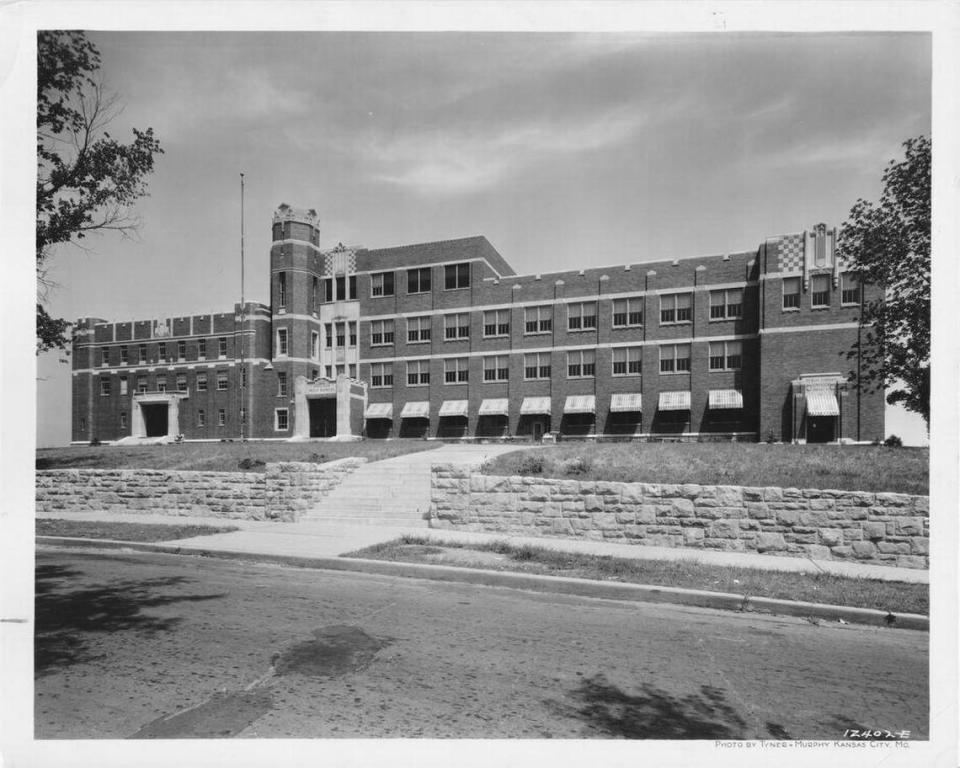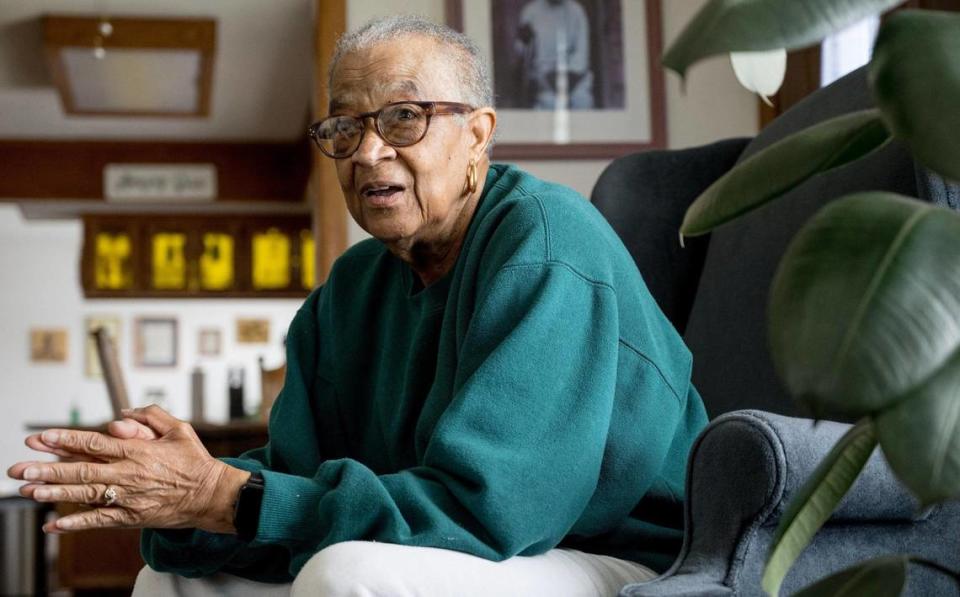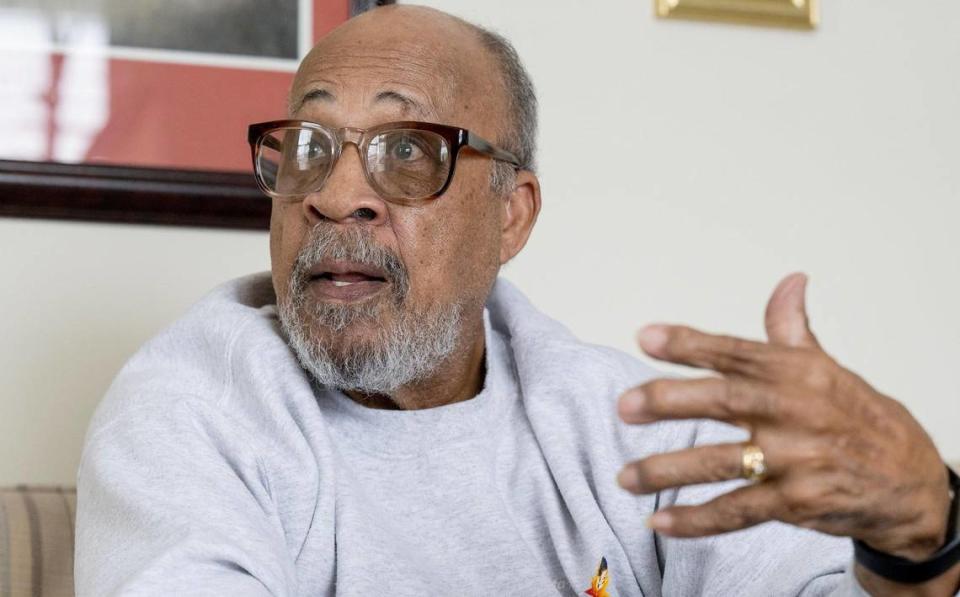The ‘Castle on the Hill’: Inside the history of Kansas City’s all-Black high school
Kansas City native Ronald Walton feels he didn’t fully appreciate the opportunities he found at Lincoln High School while enrolled there in the 1950’s.
But today, he and his wife Grace Hardiman, a fellow alumnus, are dedicated to preserving the school’s history.
Walton graduated from the high school in 1954 and went on to live in California for decades until an impromptu Lincoln alumni reunion inspired him to return to his hometown of Kansas City. Over the years, he had maintained a friendship with Hardiman, a longtime Social Security employee turned elementary school teacher who graduated from Lincoln in 1955.
Now both retired, the couple has worked to assemble an archive of photos, trophies and other memorabilia documenting the school’s storied legacy within Kansas City’s Black community.
For nearly a century, Lincoln operated as an all-Black high school within a segregated public school system that systematically denied it the funding and other resources needed to serve its growing student population. In the 1930’s, after decades of overcrowding, the school moved to its current location at Woodland and East 22nd Streets, according to archival research conducted through the Kansas City Public Library. This new location earned it the moniker of “castle on the hill”.
Students at Lincoln have long enjoyed the instruction of world-class Black educators, according to the Kansas City Call, a historically Black local newspaper. Prior to integration, many of Lincoln’s teachers were qualified to be university professors, but were denied positions in higher education due to systemic racism.

Also of note was Lincoln’s consistent message of community responsibility. Black leaders impressed the importance of Lincoln’s education upon its students, both as a means of social mobility and to advance the cultural prominence of Kansas City’s Black community as a whole.
Even after U.S. public schools were desegregated by the U.S. Supreme Court ruling in Brown v. Board of Education in 1954, de facto segregation continued in the Kansas City Public School District for many years through geographic grouping of school populations.
Now known as the Lincoln College Preparatory Academy, the school maintains a predominantly Black student population of around 1,000 students. It is ranked the seventh best high school in the state of Missouri by the U.S. News & World Report and the best high school in the Kansas City area for 2024 by the school ranking site Niche. According to state data, 90% of Lincoln’s graduates go on to enter a two or four-year college or university program.
The Star sat down with Walton and Hardiman to hear about the student experience under segregation and how their time at the school has impacted their lives. The interview has been edited for length and clarity.

I understand you went to Lincoln while the school system was still under segregation. What was it like being in an all-Black school environment?
Hardiman: For us, it was just a part of life. I knew my boundaries. I had my friends. We stayed in our boundaries and we had fun. So I didn’t worry about what was outside — I had everything that I needed in the community. The only time it dawned on me was when I went to college, and it was a mixed group. But when I was growing up, it didn’t bother me.
Walton: That’s all we knew. If you’ve only attended Black schools, you don’t know anything else but Black schools. You don’t have any experience anywhere else. But it was amazing, because as a child going to primary school, and leading up to junior high school, it was just something that you looked forward to.
Going to Lincoln was the epitome of education. To go into one of the most modern schools in the city, that was strictly for Blacks, was amazing. It seemed like everybody in the school had a personal interest in you, as an individual.
How did that impact your experience as a student there?
Walton: It made me who I am today. I was a bad boy, I was a cut-up in school. I couldn’t separate the education from the social. Rather than going from one class to another, I found things to do in between which weren’t conducive to me being a good student. And I got caught and called on it, and I wasn’t punished — I was cared for.
The principal, Earl B. Thomas, took a special interest in me and gave me a part-time job on the weekend. And teachers were alerted that Ron is a problem child, so let’s keep him on the straight and narrow. And as hard as they tried, I found more ways to stray from that straight and narrow.
What sort of things did you get up to — if you don’t mind me asking?
Walton: Well, you know, gambling, or what we called gambling — tossing pennies in between class. I’d spend two, three, four minutes doing that, and wind up being late for class and getting sent to the office and being reprimanded. When it was time to do class work, my mind didn’t lock in. I was thinking about other things. In my senior year, I messed around and got expelled from school, and couldn’t go back until my parents went with me to the Board of Education. I was girl crazy, that’s what it boiled down to.

It sounds like the teachers put a lot of care into getting you back on track.
Walton: A lot of care. There were a couple of teachers that even had me come to their house and do little chores. Miss Hopkins, she taught home economics, and she wasn’t even one of my teachers. She reached out to me and asked me if I’d be interested in earning some money, and I said yes.
The teachers weren’t the young, fresh teachers out of college. These were teachers that were in their 40s and 50s, that had been qualified to teach anywhere in the country but were denied that opportunity. They had master’s degrees, oh, all kinds of degrees.
Did you have a favorite teacher while you were there, that you still remember?
Walton: He was a science teacher, Mr. McCreary. He was also the coach on the football team. And he took special interest in me.
What did you like about him?
Walton: Just his calm demeanor. He never seemed to be excited about anything. Just very calm, and he just had a way of communicating that you didn’t miss what he was talking to you about.
When the schools were officially desegregated, how did that impact the student experience at Lincoln?
Walton: Even when integration came, the Black kids weren’t so eager to go out to the other schools. And the non-minority population wasn’t so eager to come in. So it took two or three years before the mixing started.
Hardiman: The year that they integrated, I had a choice where I could stay at Lincoln or go to Central or some other school. Nope. I decided no, my friends were here, and this is what I love, this is what I enjoy. I had wonderful teachers. So I felt like that was where I belonged. I don’t think any of my classmates left Lincoln.
What did you do for fun back in those days?
Hardiman: In the summertime we had the park, we could play baseball and we just lived in the park. And in the winter we had sleds, sleigh rides and everything else. The city would put a big barrel out where they’d burn wood and paper, and we could warm up around there.
Walton: We did the same things that other kids did. We just did it within boundaries. It happened to me once — I was visiting my aunt and there were a couple of kids next door that were my age. We went on over to the park and were playing, and after maybe an hour or so he said, “We’d better go.” I said, “Why go? We’re having fun.” He said, “Well, we can’t be in the park when those white kids come over here. They’ll beat us up.” So we left the park.
Hardiman: We could go to Swope Park, but we always had to go to one place. And they called it “Watermelon Hill.” That’s where we would go to the shelters and picnic and everything else. In the school year, classes would have picnics in the park where you’d bring your lunch, and the bus would take us to Watermelon Hill. And we’d go to the zoo and the swinging bridge and the boat house, but you only had that certain area.
Was that something that the city explicitly stated, or was it more like nobody really says it, but everyone understands that that’s the one Black area?
Walton: That was it. If you went to another area in the park, you’d get the looks and the non-Blacks would crowd around you. They’d set up their blankets and things. You got the message.
Hardiman: I don’t think anybody really tried to, because you knew you were going to Watermelon Hill, so you’d just go to Watermelon Hill and have your fun.
They also had a park at 75th and Prospect, Fairyland Park. A big amusement park. And we could go to Fairyland Park one day a year to ride the roller coasters, Ferris wheels and all that. But I don’t remember ever going because my mother said, we’re not going because we can only go one day a year.
Walton: We went that one day and we tested the rides, so if anything was wrong with them, we would suffer.
Hardiman: Because they were closed over the winter.
Walton: At the beginning of the season, we tested the rides. Without knowing. I don’t know that anybody was aware that that was being done. I saw people say, “Oh, they’re opening up the park. They’re going to let the Blacks go.” And us, young and not knowing, we were just clamoring to go.
Hardiman: I had a wonderful childhood. I really did. Because that stuff didn’t bother me. I did what I was supposed to do when I went to school. I loved all my teachers, I really did. They were strict, believe me. Really strict, but you know deep down that they’re there for you.
What do you want to know about Black history in Kansas City? Do you or a loved one have a compelling story to share? Let the Service Journalism team know by emailing kcq@kcstar.com.

